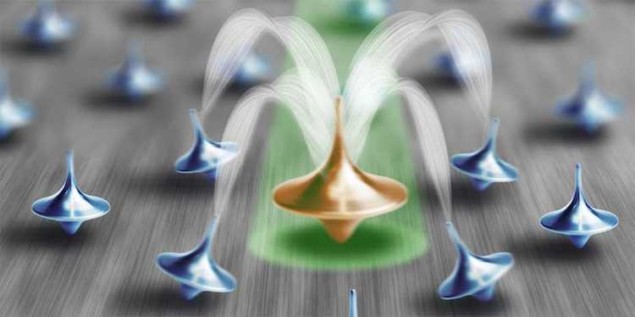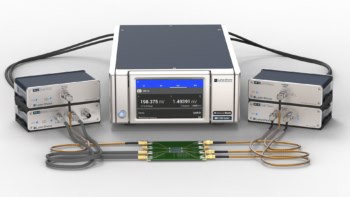
Nuclear magnetic resonance (NMR) spectroscopy is an invaluable technique for analysing the structure of molecules and for imaging their spin densities in 3D. The technique works by placing the sample in a strong magnetic field, which causes atomic nuclei with a non-zero magnetic moment (their spin) to align parallel or anti-parallel to the field. If the spins are tilted perpendicular to the field, by applying radiofrequency waves, they start to oscillate (or precess) along the external magnetic field direction. This free precession generates an electromagnetic signal that can then be measured using an induction coil.
There are downsides to the technique, however. For one, it requires strong magnetic fields, and it is also relatively insensitive – requiring at least 1012 to 1018 atomic nuclei to produce a detectable signal.
New approach
Physicists at ETH Zurich led by Christian Degen have now developed a new approach to NMR that allows them to directly track the precession of single nuclear spins. Until now, they were not sure that this was even possible because of an effect called quantum back-action, which is the disturbing effect that a measurement itself introduces onto the state of the quantum system being measured. In general, measurements in quantum mechanics are usually projective, which means that a measurement projects (or collapses or disturbs) the state of the quantum system it is measuring.
In their experiments, Degen and colleagues used the spin of an electron in a nitrogen-vacancy (N-V) centre in diamond as a sensor to measure the precession of carbon-13 nuclei. A N-V centre is an imperfection in the diamond lattice and occurs when two carbon atoms are replaced with a vacancy and a nitrogen atom. It is essentially a tiny magnet isolated from its surroundings.
Overcoming the disturbing effect of quantum back-action
The quantum back-action effect means that the researchers were unable to track the precession continuously. This is because the measurements induce two important effects: decoherence and frequency synchronization with the detector (or sampling clock as it is known). Decoherence results in a measurement-induced decay of the signal, explains team member and lead author of the study, Kristian Cujia. And synchronization with the detector occurs for sampling rates that are commensurate with the precession frequency of the nuclear spin.
To overcome these problems, the ETH Zurich physicists developed a new measurement technique to detect the spin of the carbon-13 atom through a series of rapid, periodic weak measurements performed one after the other. This approach meant that the measurements were not fully projective – that is, they only partially disturbed the state of the spin being measured, explains Cujia. The original precession could thus be measured.
Towards atomic-scale analysis
The researchers say that their technique “could pave the way to remarkable advances in NMR technology” and potentially allow them to directly record the spectra of individual molecules and analyse structures at the atomic level. Indeed, they have already identified the 3D position of the carbon-13 nuclei in their diamond lattice with atomic-scale resolution.

Diamond quantum sensor breaks new record
“We see our strategy of sequential/periodic weak measurements as being the equivalent of inductive detection in conventional NMR,” Cujia tells Physics World. “It could thus benefit from the many existing NMR protocols and methods to study systems on the molecular scale.”
Such detailed NMR measurements could lead to completely new insights in many areas, adds Degen, as has already been the case with conventional NMR spectroscopy in recent decades.
Full details of the research are reported in Nature 10.1038/s41586-019-1334-9.



